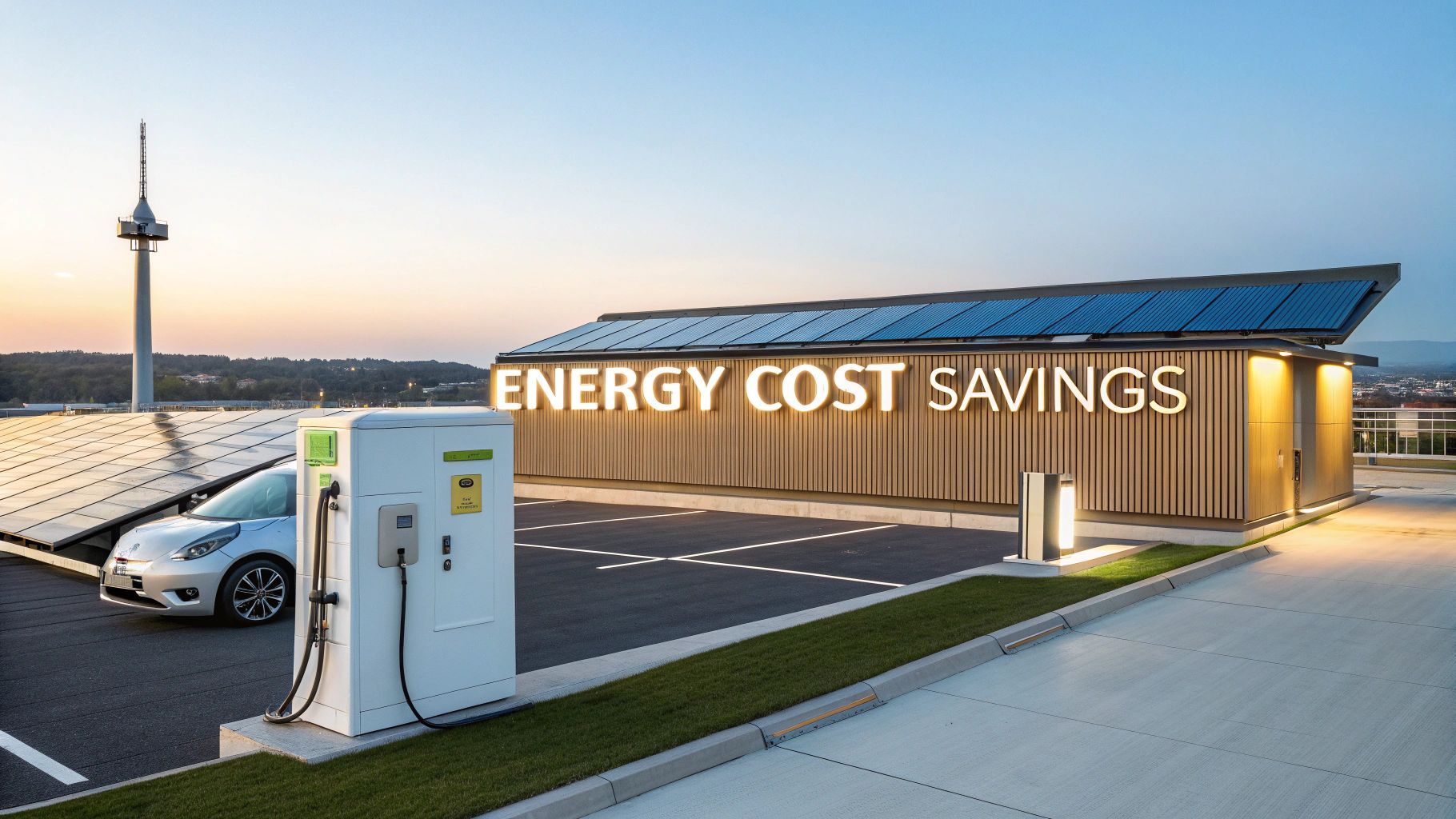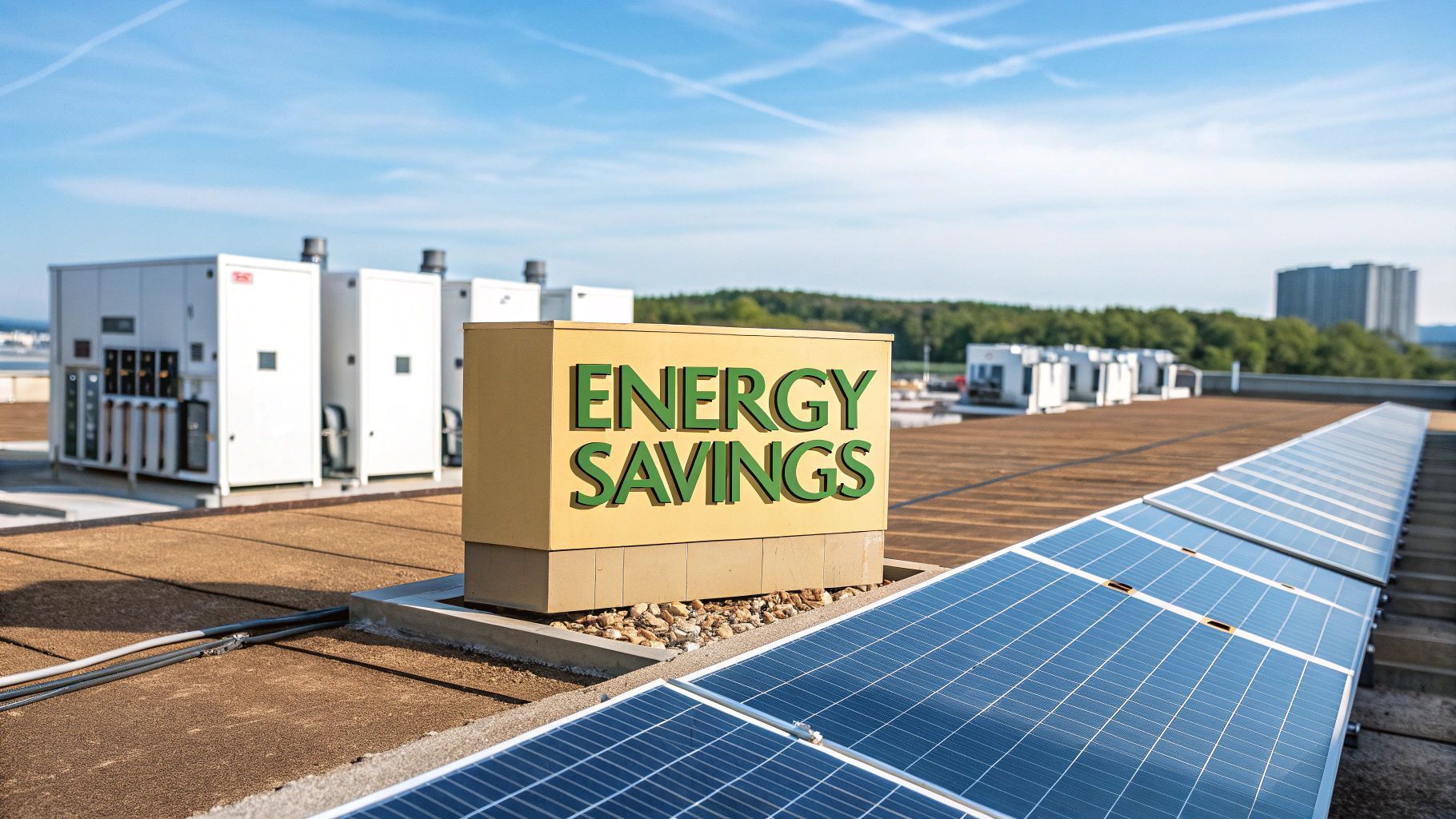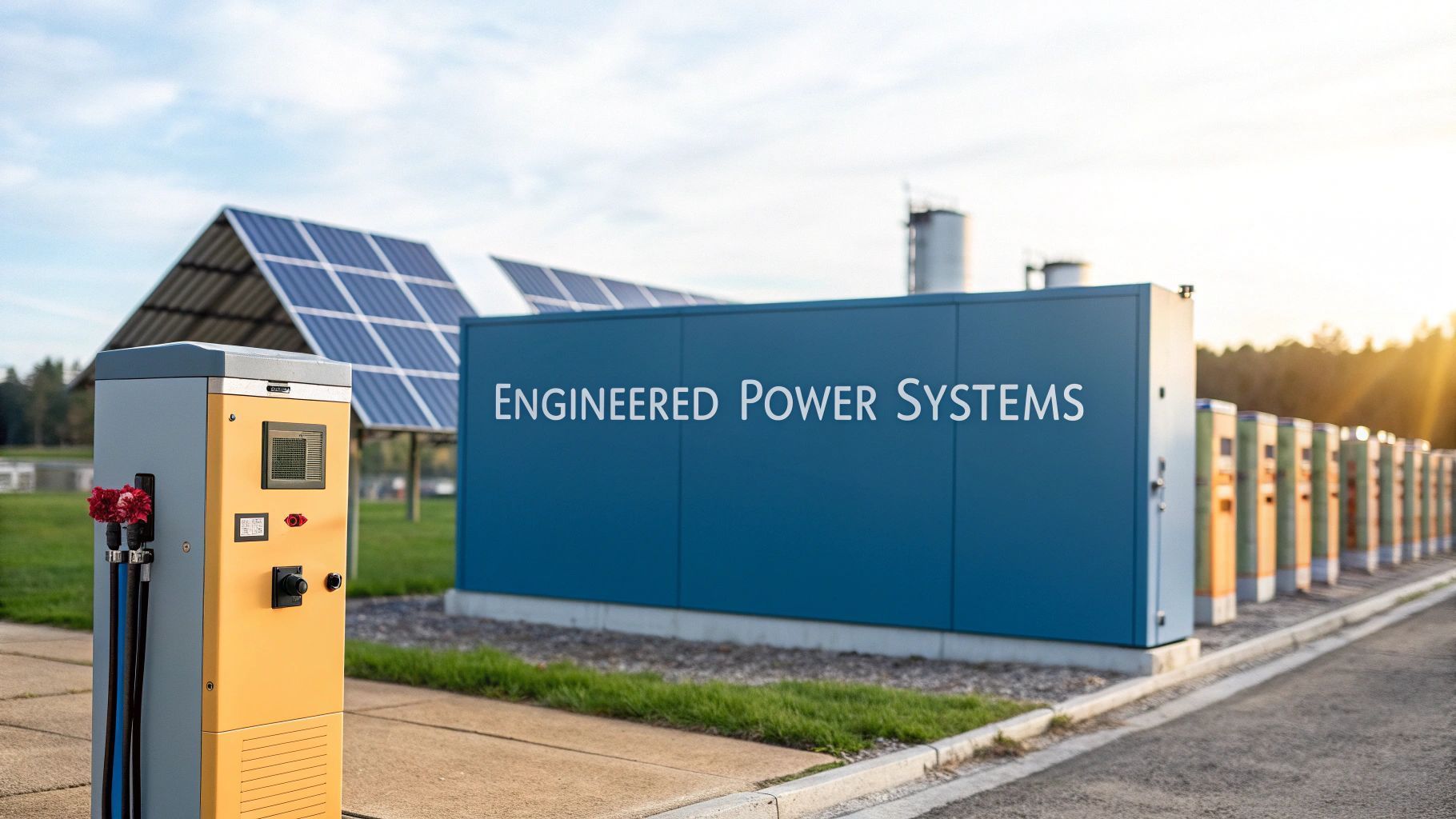UK Battery Energy Storage System: A Complete Guide for 2024
Think of a battery energy storage system (BESS) as a huge, rechargeable power bank but one designed to support the entire UK national grid. It’s a beautifully simple concept: capture electricity when it’s plentiful and cheap—like on a fiercely windy or brilliantly sunny day—and save it for when demand is high or renewables are not generating. This technology is quickly becoming the lynchpin for balancing the UK’s power supply and making a clean energy future a reality.
The Foundation of the UK’s Modern Energy Grid
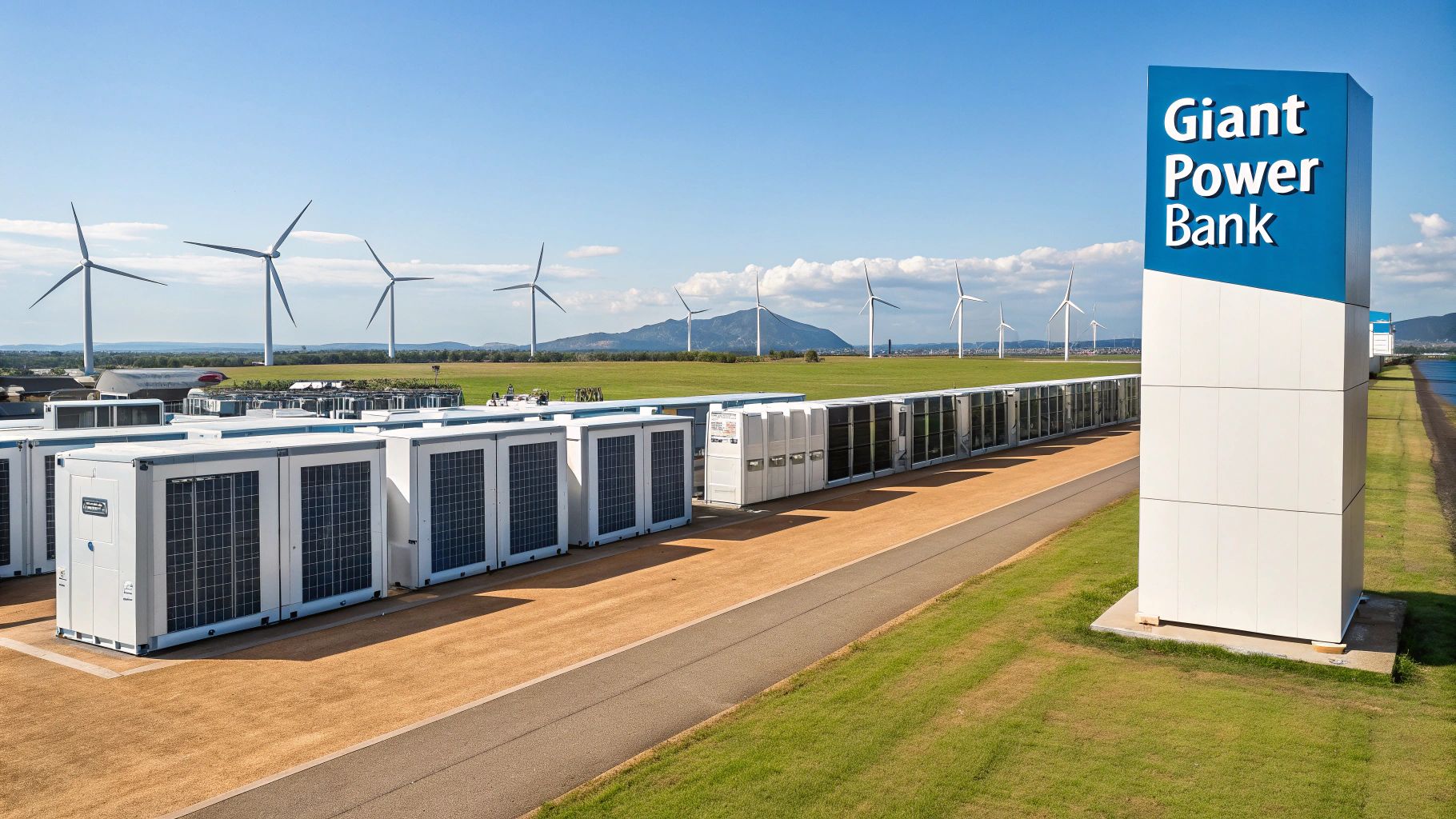
Picture the national grid as a finely tuned balancing act. On one side you have all the electricity being generated and on the other you have everyone plugging in and using it. For decades this was a straightforward job managed by predictable fossil fuel power stations that could be cranked up or down on command but with the incredible rise of renewables like wind and solar, that balancing act has become a lot more complex.
The sun doesn't always shine and the wind doesn't always blow. This creates gaps and surges—intermittency—in power generation. This is the exact problem a battery energy storage system UK is built to solve. It acts as a critical buffer, smoothing out the peaks and troughs of renewable energy and keeping the grid stable.
Why Is Battery Storage So Important Now?
Honestly, the UK's entire mission to decarbonise hinges on these systems. They provide the flexibility and stability we need to integrate enormous amounts of clean energy without the grid becoming unreliable. A battery can respond to changes in supply and demand in milliseconds, offering a level of control that traditional power plants simply cannot match.
At its heart, a battery energy storage system decouples electricity generation from consumption. This simple function is what unlocks the full potential of renewables and strengthens our national energy security.
This capability is especially vital for new, intense energy demands. For example, setting up hubs for rapid EV charging puts a huge, sudden strain on the local grid. A BESS can absorb this pressure entirely. It quietly charges up using cheap off-peak power overnight then discharges in a powerful burst to juice up cars during the day. This completely sidesteps the need for eye-wateringly expensive and slow grid upgrades, making widespread EV adoption a practical reality, especially for EV charging from constrained grid connections .
Meeting Future Energy Demands
The strategic importance of this tech is now baked into national policy. The UK government's Clean Power 2030 Action Plan estimates we will need between 23 GW and 27 GW of battery storage capacity by 2030 . That’s a monumental leap from the roughly 4.5 GW we had in early 2024, highlighting just how fundamental these systems are to our future. You can discover more insights about the role of batteries on RenewableUK.com.
As our grid becomes more decentralised—with businesses generating their own solar power and other distributed energy assets coming online—the need for smart storage just keeps growing. From massive grid scale batteries to smaller units paired with EV chargers, these systems are the essential building blocks of a modern, resilient energy network. Understanding what makes these advanced energy storage systems so effective is key to appreciating their role in this energy transition.
Mapping the UK’s Battery Storage Boom
What was once a niche technology is now becoming a cornerstone of the UK’s national infrastructure. The country is in the middle of a dramatic and rapid build-out of battery storage capacity with new projects coming online at a pace that would have been hard to imagine just a few years ago. This isn't a gradual shift; it's a full-scale boom, driven by clear strategic needs and powerful market forces.
This growth is absolutely essential for creating the modern, flexible grid the UK needs to function. As we bring huge amounts of renewable energy online and encourage the switch to electric transport, the role of a battery energy storage system UK becomes more critical by the day. These systems provide the stability required to manage the natural ups and downs of wind and solar power.
The Forces Driving Expansion
So what’s fuelling this remarkable expansion? A huge driver is the falling cost of battery technology itself which has finally made grid-scale projects commercially viable. This cost reduction has happened at the perfect time, meeting supportive government policies and ambitious net-zero targets to create fertile ground for investment.
There's also a powerful commercial appetite for green investments that deliver tangible results. Investors and developers have spotted the multiple ways battery storage can make money, from balancing the national grid to enabling new energy-hungry services like widespread rapid EV charging . It all adds up to a very strong business case for putting more battery capacity on the ground.
The surge in battery storage is a direct response to the practical challenges of decarbonisation. It solves the intermittency of renewables and unlocks new capabilities, such as overcoming grid limitations for EV infrastructure.
To put this growth into perspective, operational battery storage capacity in the UK has skyrocketed by 509% since 2020. We've gone from 1,128 MW in 2020 to a projected 6,872 MW in 2025. This explosion in capacity shows just how committed the UK has become to integrating this technology. By 2025, over 79% of this capacity will be in England, with Scotland holding 16% , followed by Northern Ireland at 3% and Wales with 2% . You can dig deeper into these numbers in the UK battery market report on RenewableUK.com.
Geographical Spread and Project Scale
While England currently leads the pack—thanks to its population density and energy demand—we're seeing significant projects pop up across all the home nations. Large-scale batteries are often strategically placed near major renewable energy hubs or at key points in the national grid where they can provide the most support.
And we're not talking about minor installations. The average size of new projects is getting bigger, reflecting a growing confidence and ambition in the sector. The pipeline of future projects is even more impressive, with gigawatts of capacity already approved or waiting for planning permission. This all points to a sustained period of growth that will continue to reshape the UK's energy system for years to come.
This growing capacity is being applied in increasingly diverse and localised ways. The key areas of focus include:
- Grid Scale Batteries: Huge installations that provide essential balancing services to the National Grid, making sure millions of homes and businesses have a stable, reliable power supply.
- EV Charging Hubs: Co-locating batteries with rapid EV charging stations is a clever way to bypass local grid constraints. This allows for super-fast charging in places that previously couldn't support it.
- Distributed Energy: Businesses are now pairing batteries with their own on-site renewables, like solar panels. This is a form of combined on site renewables, EV charging and batteries , which helps them manage energy costs, improve resilience and even make money by selling power back to the grid.
This mix of massive grid-scale infrastructure and smaller, localised assets really shows the versatility of a modern battery energy storage system. The UK's boom isn't just about building bigger batteries—it's about deploying them more intelligently to solve real-world energy challenges.
How Battery Storage Powers Modern Energy Needs
A battery energy storage system is so much more than just a big box that holds power. Think of it as an active, intelligent player in the UK's energy grid—a problem-solver for grid operators, businesses and EV drivers. These systems are the unseen workhorses making a cleaner, more reliable energy network possible.
Their most critical job is supporting the National Grid. Grid-scale batteries act like shock absorbers for the entire country's electricity supply. They can react in milliseconds to tiny wobbles in grid frequency—the steady 50Hz heartbeat of our system. This is a service known as frequency response . If demand suddenly shoots up or a power station unexpectedly trips offline, these batteries instantly inject power to keep everything stable and prevent blackouts.
Unlocking the Potential of Electric Vehicles
Perhaps the most exciting application for a battery energy storage system UK is its partnership with electric vehicle charging. The rollout of rapid EV charging has hit a major snag: weak grid connections. Many of the best spots for charging hubs, like motorway services or retail parks, just don't have enough power from the grid to run multiple high-speed chargers at once. This challenge of EV charging from constrained grid connections is a significant barrier.
This is where batteries completely change the game. By placing a battery next to a charging hub, you create a local energy reservoir. The battery can trickle-charge from the grid during off-peak hours when power is cheap and plentiful.
Then, when a line of EVs pulls in needing a fast charge, the battery discharges its stored energy at a high rate to power the chargers, completely sidestepping the local grid's limitations. This solves a massive logistical and financial headache, avoiding the years of work and millions in costs needed for a grid upgrade.
It also paves the way for innovations like mobile EV charging . A large battery on the back of a lorry can be driven to provide temporary rapid charging at events, support fleet depots during busy periods or even rescue stranded motorists. It’s a flexible solution that puts power exactly where it’s needed.
The infographic below shows just how neatly these elements—renewables, battery storage and EV charging—can fit together.
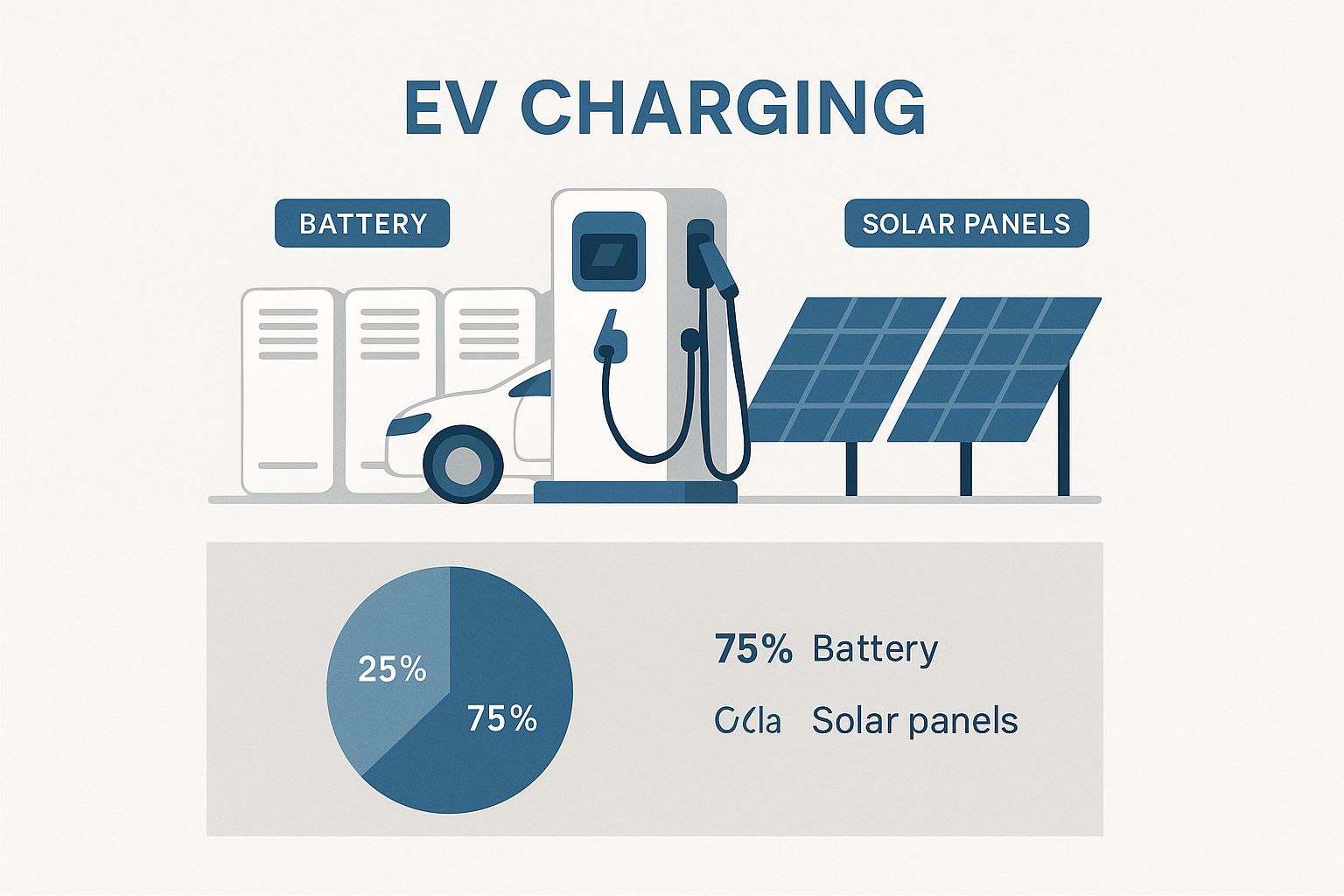
Here you can see a modern EV charging station powered by on-site battery containers and solar panels, creating a powerful and self-sufficient local energy hub.
Creating Distributed Energy Hubs
Beyond the grid and EVs, batteries are the cornerstone of the move towards distributed energy . All across the UK businesses are putting solar panels on their roofs to generate their own clean power but when you pair those panels with a battery, you turn a simple generator into a truly sophisticated energy asset.
By combining on-site renewables with battery storage, businesses can achieve greater energy independence, reduce their reliance on the grid and slash their electricity bills. This combination turns a passive energy consumer into an active participant in the energy market.
During the day, solar panels power the building and charge the battery at the same time. Any extra energy gets stored instead of being sold back to the grid for a pittance. Later, when the sun goes down but the lights are still on, the business can draw from its own stored solar power instead of buying expensive peak-rate electricity. This is a core strategy for energy self-sufficiency and you can learn more about integrating renewable energy with advanced storage solutions to see how these systems come together.
This setup doesn’t just save money; it can make money. A business with a battery can offer its services to the grid, getting paid to help balance national supply and demand. This creates a powerful business case for investing in a battery energy storage system , turning what was once just a utility bill into a source of revenue.
The table below breaks down the key ways these systems are being put to work across the UK.
Key Applications of Battery Energy Storage in the UK
| Application Area | Primary Function | Key Impact for the UK |
|---|---|---|
| Grid Balancing | Providing rapid-response services like frequency control to stabilise the grid. | Increases grid resilience, prevents blackouts and allows for higher integration of renewables. |
| Renewable Integration | Storing excess wind and solar energy when generation is high and releasing it when it's low. | Makes intermittent renewables a reliable, 24/7 power source, reducing reliance on fossil fuels. |
| EV Charging Infrastructure | Overcoming local grid constraints to enable high-speed, multi-vehicle charging hubs. | Accelerates the EV transition by making rapid charging viable in more locations without costly grid upgrades. |
| Commercial & Industrial | Reducing electricity bills by storing cheap off-peak energy and avoiding peak-time tariffs. | Lowers operational costs for businesses, improves their carbon footprint and creates new revenue streams. |
| Capacity Market | Acting as a reserve power source, ready to deliver energy during periods of high national demand. | Ensures the UK has enough power to meet demand during winter peaks, enhancing energy security. |
Each of these applications demonstrates how batteries are not just a storage device but a dynamic tool for building a smarter, more efficient and greener energy future for the UK.
Understanding UK Policies and Market Opportunities
For a battery energy storage system in the UK to go from a good idea to a profitable asset, it needs two things: a supportive government and clear ways to make money. Thankfully we have both. The UK government sees battery storage as absolutely essential for its net-zero ambitions, which has led to policies and financial incentives that actively encourage putting these systems in the ground.
This isn't just about hitting climate targets though. It's about building a smarter, more resilient national grid. As the country shifts towards renewables and high-demand tech like rapid EV charging , batteries provide the flexibility the grid desperately needs. This has fired up a dynamic market where battery owners can earn serious money simply by helping to keep the lights on.
The Key Revenue Streams For Battery Storage
A grid-scale battery in the UK doesn't just rely on a single income source. Instead it cleverly "stacks" several different revenue streams by participating in various energy markets run by the National Grid ESO. It's this diversification that makes the business case so strong.
Here are the main ways a battery makes money:
- Frequency Response Services: This is one of the most vital jobs. The grid's frequency must be held at a rock-steady 50Hz . Batteries can inject or absorb power almost instantly to correct tiny fluctuations, getting paid handsomely for their speed and reliability.
- The Balancing Mechanism (BM): Think of this as a real-time market where the National Grid pays generators to ramp up or down to balance supply and demand. Batteries are perfect for this role, responding to signals in seconds to prevent blackouts.
- Wholesale Arbitrage: This is the classic "buy low, sell high" model. The battery charges up when electricity is cheap (like overnight or on a windy day) and sells that power back to the grid when prices spike during peak demand.
- The Capacity Market: This is a bit like an insurance policy for the grid. Battery owners are paid a retainer just to guarantee their asset will be ready to deliver power during moments of high stress, like a cold winter evening.
By blending these different income streams, a single battery energy storage system can maximise its value and deliver a powerful return on investment. Some operators also lock in long-term revenue by signing a Power Purchase Agreement (PPA). To get a better handle on how those work, check out our simple guide on what a PPA involves.
Navigating the Planning and Approval Process
Of course before a battery can start earning, it needs to be built. The planning and approval process is a critical hurdle but the good news is that projects are getting the green light faster than ever. The first half of 2025 saw a massive surge, with a 78% year-on-year increase in project completions.
During this period, local authorities approved an impressive 1,237 MW of grid-scale battery storage. This shows there's a growing official understanding of just how important this technology is, smoothing the path for future developments.
The pipeline of new projects is incredibly strong, with 68 GWh of capacity submitted for planning and over 130 GWh already approved. This momentum is a clear sign that developers and planning authorities are finally on the same page. As reported on Energy-Storage.News , this forward pipeline is a powerful indicator of the sector's health and its central role in the UK's energy future, from enabling grid scale batteries to supporting EV charging from constrained grid connections .
Future Trends and Overcoming Industry Hurdles
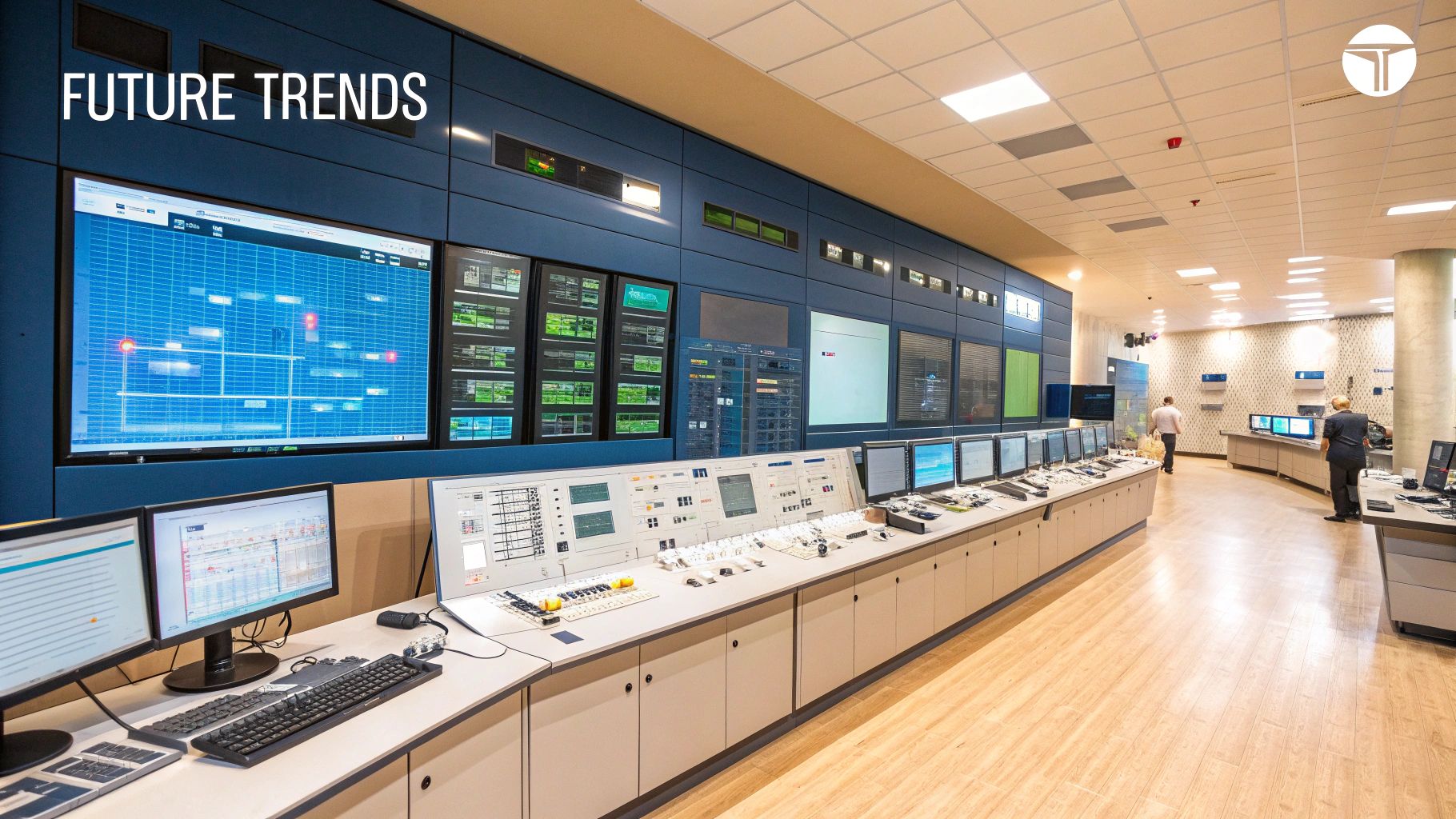
While the growth of the battery energy storage system UK market has been impressive, it's not without its growing pains. The industry is navigating a few significant hurdles that need smart solutions if we're to maintain this incredible momentum. Understanding these challenges is the first step to appreciating just how innovative the road ahead will be.
One of the biggest headaches for developers is simply getting a grid connection. The queue to plug new projects into the national grid is notoriously long and it's only getting longer. This bottleneck can stall good projects for years, turning a straightforward deployment into a frustrating waiting game. For anyone trying to deliver EV charging from constrained grid connections , these delays can be a total showstopper.
Then there’s the global supply chain. Lithium-ion is still king but its key ingredients—lithium, cobalt and nickel—are in hot demand all over the world. This creates a volatile market where prices can swing and shortages can loom, making project financing a much trickier business.
Ironically, the sector's own success is creating commercial challenges. With more batteries coming online, the competition for revenue streams like frequency response is heating up. This saturation can squeeze profit margins, forcing operators to get much cleverer about how they stack revenues and prove their asset’s worth.
The Next Wave of Battery Technology
The industry isn't just sitting back and watching though. The next decade will bring a major shift in the technology and strategies used in a battery energy storage system UK context, with innovation pushing hard on both performance and sustainability.
One of the most exciting frontiers is the move to longer-duration storage. Today's lithium-ion batteries are fantastic for those quick-fire grid services that last a few hours but there’s a massive, growing need for systems that can hold onto energy for days, or even weeks. Imagine storing all the excess power from a blustery week of wind and deploying it during a calm, still period—that’s the goal.
This is fuelling a race to develop alternative battery chemistries. Technologies like sodium-ion and flow batteries are showing real promise. While still in their early days, they could reduce our reliance on those critical minerals like lithium and offer far better performance for those long-duration jobs.
The future of grid stability won’t hang on a single technology but on a diverse portfolio of storage solutions. The real challenge is shifting our mindset from short-term balancing to long-term energy shifting, guaranteeing clean power is there 24/7, whatever the weather is doing.
Smarter Systems and Artificial Intelligence
It’s not just about the hardware. The software controlling these systems is getting seriously sophisticated. Artificial intelligence (AI) and machine learning are the brains behind the next generation of smart, distributed energy networks. AI algorithms can crunch thousands of data points in real-time—from weather forecasts and wholesale energy prices to local demand—making split-second decisions.
This intelligent optimisation means a battery is always working in the most profitable way possible. It might choose to charge up ahead of a price spike, sell power into the Balancing Mechanism or offer a boost to a local rapid EV charging hub.
These smart systems are absolutely essential for managing the grid of the future which will be far more complex and decentralised. We're talking about coordinating thousands of assets, from huge grid scale batteries right down to the battery in your car, all working in concert to create a stable, efficient network. That level of automation is what will truly unlock the full power of battery storage.
The Indispensable Role of UK Battery Storage
It's been quite a journey for battery energy storage in the UK. Not so long ago it was a niche idea but now it’s become a cornerstone of our national infrastructure. It’s clear these systems are much more than just passive power banks; they are active, intelligent assets that are absolutely vital for building a modern, green energy grid. In short, they are the key to unlocking the true potential of renewables and, quite simply, keeping the lights on.
Think about it. From enabling rapid EV charging where the grid is too weak, to providing the entire country with millisecond-fast grid stability, battery storage is a multi-talented workhorse. It’s what makes large, grid-scale batteries possible while also empowering smaller, distributed energy assets, creating a power network that's far more resilient and flexible.
These systems give us the rock-solid stability needed to manage the fluctuating output from combined on site renewables , turning clean energy into a dependable, 24/7 resource.
Moving forward, battery storage isn't just a nice-to-have, it’s a necessity. It is the fundamental technology that will allow the UK to securely manage its transition to a fully decarbonised energy future and actually meet its ambitious clean energy targets. The continued growth of this sector is essential for our national energy security.
Your Questions Answered
Getting to grips with the specifics of a battery energy storage system in the UK is the first step to understanding its true value. Here we'll tackle some of the most common questions and give you straight answers on how this technology is reshaping our energy landscape, from powering electric cars to supporting the national grid.
How Does a Battery System Enable Rapid EV Charging?
Rapid EV chargers draw a massive amount of power in a short burst—far more than many local grid connections can safely handle. This is a common headache in rural locations or older industrial areas. A battery energy storage system neatly sidesteps this problem by acting as a powerful energy buffer.
Think of it this way: the battery slowly fills up with power from the grid during quiet, off-peak hours. When a driver plugs in, the system instantly unleashes that stored energy at a high rate, feeding the charger directly and completely bypassing the grid's limitations. This is a key solution for enabling EV charging from constrained grid connections .
This clever approach means you don't need to sink money into expensive and time-consuming grid upgrades. It's what makes it possible to install rapid EV charging hubs and even mobile EV charging solutions in locations that would otherwise be off-limits, which is a massive step forward in building a truly nationwide charging network.
What Are the Main Revenue Streams for a Grid-Scale Battery in the UK?
Grid-scale batteries in the UK don't just do one job. They earn their keep by "stacking" multiple revenue streams from different energy markets, a financial flexibility that makes them such a solid investment.
Here are the main ways they generate income:
- Frequency Response: The National Grid pays the battery to make tiny, lightning-fast adjustments—charging or discharging—to keep the grid's frequency perfectly stable at 50Hz . It's a vital service that keeps the lights on.
- Wholesale Arbitrage: This is the classic "buy low, sell high" play. The system charges up with cheap electricity during off-peak times (like the middle of the night) and sells it back to the grid when prices peak during high demand.
- The Balancing Mechanism: The battery helps the National Grid manage real-time gaps between electricity supply and demand. It gets paid to respond to signals and help keep the entire system in perfect balance.
- The Capacity Market: This works a bit like an insurance policy. The battery receives regular payments just for being available to deliver power during periods of high national demand, guaranteeing a reliable supply when it's needed most.
Are Battery Storage Systems Environmentally Friendly?
Absolutely. In fact, battery storage is one of the most important tools we have for building a greener energy system. The single biggest environmental benefit is that these systems allow us to use far more renewable energy from wind and solar, directly cutting the UK's reliance on fossil-fuel power stations for grid stability.
At its heart, a battery energy storage system is designed to turn intermittent renewables into a reliable, 24/7 power source. This role is absolutely essential for hitting the UK's decarbonisation targets and building a clean energy future.
Of course it's important to look at the whole picture. Manufacturing lithium-ion batteries involves mining raw materials which has its own environmental footprint. The industry is working hard on this, developing more sustainable battery chemistries and creating a proper circular economy through advanced recycling programmes. When you weigh everything up, the net impact of a battery energy storage system is overwhelmingly positive for decarbonisation.
At ZPN Energy , we are dedicated to building the backbone of the UK's modern energy infrastructure. From overcoming grid constraints for rapid EV charging to deploying intelligent battery storage, our integrated solutions are designed to deliver reliable, sustainable and profitable energy management. Discover our advanced systems at https://www.zpnenergy.com.


